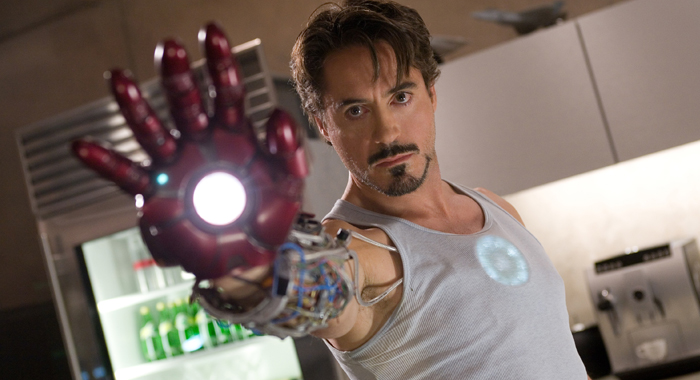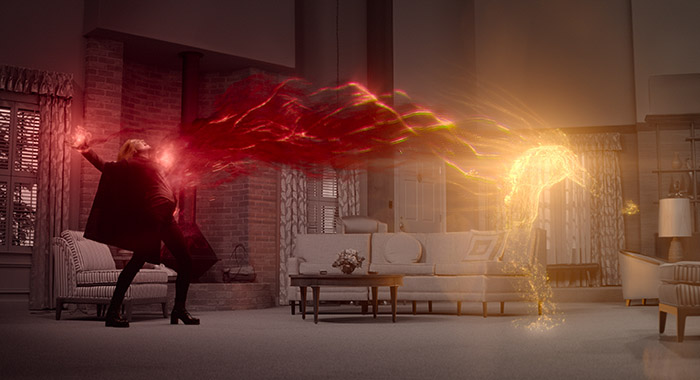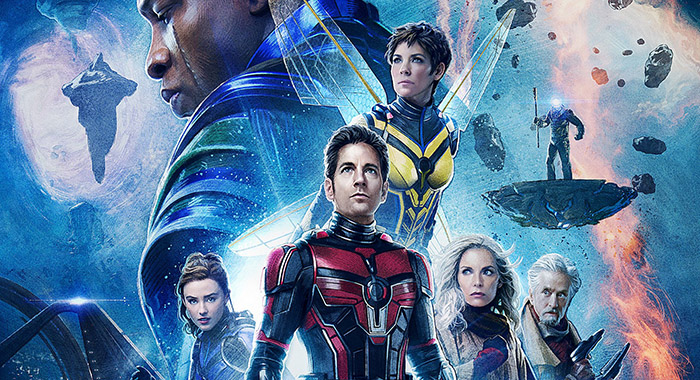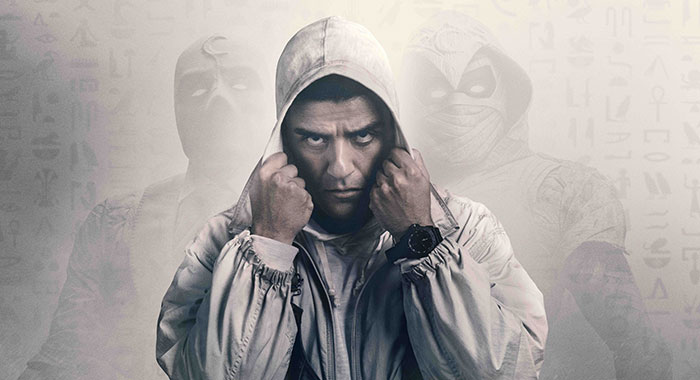TAGGED AS: Disney, Marvel Studios, Marvel Television, streaming, television, TV

Charlie Cox in Marvel’s Daredevil key art (Photo by Netflix)
Marvel Comics is known for its up and downs — not just in regards to the lives of its costumed characters, but also in the ways it does business. The creation of Marvel Studios and Disney’s ownership of the Avengers, for one, has its roots in one of the roughest periods Marvel — no matter its corporate name or parent company — ever faced. And, because everything is cyclical with superheroes, Marvel Studios currently faces one of its biggest challenges to date.
The head writers of the upcoming Daredevil: Born Again Disney+ series were dismissed sometime in September with the directing team also receiving pink slips in subsequent days, THR reported in the Oct. 11 issue of its magazine. The move was part of a creative reckoning Marvel President Kevin Feige and his team could no longer ignore: Marvel Studios’ way of doing television did not work.

Daredevil: Born Again title treatment (Photo by Marvel Studios)
In the short term, Born Again will be re-conceived as something closer to Netflix’s Daredevil series (both star Charlie Cox as the title character and Vincent D’Onofrio as his key nemesis, Wilson Fisk aka Kingpin), but the reported changes occurring on the series also indicate a major rethink regarding production methods and the studio’s way of providing television to its corporate parent’s streaming service, Disney+.
We also think it is, in its way, an acknowledgment that something was going wrong at Marvel — real superhero fatigue as Marvel executives and creatives overextended themselves in an attempt to both reinvent the TV wheel and maintain the momentum of the cinematic Infinity Saga. Here’s how it happened and a few ideas about why the shake-up on Daredevil may be, ultimately, a positive development for MCU shows.

Robert Downey Jr. as Tony Stark in 2008’s Iron Man (Photo by Paramount Pictures)
Marvel Comics utilized an interesting way of creating stories known as “the Marvel Method.” In its earliest form, writer Stan Lee — who also served as an editor — provided artists with a written outline of events. The artists would then go off and produce pages. Once approved by editorial, Lee would write the final dialogue to marry whatever ideas the artists added to his own original plans. It more or less worked and writers who joined the company in Lee’s wake used it as well. Guided, of course, by the editorial team.
A similar method emerged as Feige became the de facto chief creative officer when Marvel Studios formalized and Iron Man went into production. Eventually, a grand tapestry of 23 interconnected movies emerged; all leading up to a grand climax. It was unprecedented in film, although fairly common in comics, and it worked unlike anything the business had ever seen.
Credit went to Feige as the mastermind behind diverse strands of the tapestry, from the Oscar-worthy Black Panther to the surprising crowd-pleaser Guardians of the Galaxy. Although the individual creative talents built those films into what they became, Feige’s acumen for managing all the moving parts while orchestrating a larger story won him acclaim and creative control of not just the films, but Marvel’s television slate with the expressed purpose of creating programs of the scale and quality the MCU was known for on Disney’s upcoming streaming service. The mandate was clear: keep the material coming while designing the next big saga and producing a full film slate of tentpole motion pictures.
The first move, though, was to dismantle what remained of the previous TV unit, Marvel Television, putting creative oversight on Feige and a few other executives while also instituting a new sort of Marvel Method.
Instead of a creative executive producer who typically serves as the head writer — known in the industry informally as a showrunner — being the ultimate authority responsible to deliver a television show, Marvel executives held onto the chief authority while passing on the particulars to a head writer and a pilot director who either stayed on as an EP or directed all the episodes of a given series. It is still unclear why Marvel believed emulating the hierarchies of film production under the constraints and time pressures of television was more desirable than utilizing tried-and-true TV production methods, but the results were initially encouraging.

Elizabeth Olsen as Wanda Maximoff in WandaVision (Photo by Marvel Studios)
Phase Four of the MCU began in the midst of the COVID-19 pandemic on January 15, 2021, with WandaVision. Jac Schaeffer, who remains at Marvel, served as head writer, while Matt Shakman directed all nine of the episodes, although it was originally announced as 10-part series. The program, starring Elizabeth Olsen and Paul Bettany as their Avengers character Wanda Maximoff and Vision, was creatively successful (91% on the Tomatometer) and credited with helping the still fledgling Disney+ find subscribers.
Of course, there were some hiccups. WandaVision’s 10th episode was abandoned due to the pandemic, which would impact several subsequent productions. The Falcon and the Winter Soldier, for example, was shooting in the Czech Republic when Covid arrived there, derailing the final weeks of production and reportedly causing the removal of a planned virus storyline for the antagonists — although series director Kari Skogland told Rotten Tomatoes in 2021 that no such plot was ever part of the series.
But with two shows on the service, things continued apace at Marvel, with new characters debuting in films like Black Widow, Eternals, and Shang-Chi and the Legend of the Ten Rings and popping up in series like Hawkeye and Ms. Marvel.
Among all the character introductions, though, a sensation began to creep in that it all felt directionless and underbaked. Sequel films like Thor: Love and Thunder failed to wow like their predecessors. Nonetheless, the studio pressed on, announcing The Multiverse Saga for Phases Four, Five, and Six at the 2022 San Diego Comic-Con: 17 films in total, all of the existing Disney+ TV shows and an additional five programs (another two are said to be in development), including Born Again. The presentation was emotional and overwhelming — and a glimpse, it seems, into what was about to happen.

Ant-Man and the Wasp: Quantumania poster (Photo by Walt Disney Pictures)
Phase Five opened with a critical ravaging of Ant-Man and the Wasp: Quantumania (46% on the Tomatometer), the film which introduced the saga’s antagonist, Kang (played by embattled actor Jonathan Majors). It was followed up by a change to the TV release schedule. Secret Invasion, originally meant to run in the spring, shifted to summer.
Reportedly, the change was made to accommodate The Marvels’ move to a November theatrical release date, but other reports indicated it also happened in response to a crisis on the set of Echo, the Hawkeye spin-off starring Alqua Cox and featuring Charlie Cox and D’Onofrio as their Daredevil characters. That series was meant to debut in its entirety on November 29, but that plan has been postponed to January in response to the strike actions over the summer and shake-ups at Disney, Disney+, and Marvel.
And that’s all before you factor in the shockingly negative response to Secret Invasion (54% on the Tomatometer) once it premiered, a series now said to have fallen into dysfunction during production without a proper showrunner or oversight. The head writer quit, THR reported, leading to a power struggle among the directors. When one emerged as the de facto showrunner, what was meant to be a taught spy thriller was received as prime evidence that the audience was tiring of superheroes.
Oh, and then there’s Ironheart, a program featuring Dominique Thorne’s character from Black Panther: Wakanda Forever. Although shot in 2022, it has not been scheduled for release and the last time it was referenced by Marvel, it was on the Comic-Con Phase 5 calendar that same year. One report suggests it may not surface until 2025.

Charlie Cox as Daredevil/Matt Murdock and Tatiana Maslany as She-Hulk/Jennifer “Jen” Walters in She-Hulk: Attorney at Law (Photo by Marvel Studios)
Which brings us back to Daredevil: Born Again. Announced at that Comic-Con presentation as Marvel’s first 18-episode program, it boasted Arrowverse veterans on the writing team and stars from the Netflix iteration. But according to The Hollywood Reporter’s account of the matter, head writers Matt Corman and Chris Ord built the program in the vein of She-Hulk: Attorney at Law instead of the Netflix Daredevil. Going for something more like an episodic lawyer show, Cox’s Matt Murdoch allegedly did not put on his Daredevil costume until Born Again’s fourth episode. The amended series will feature more serialization while retaining some of the material shot before production ceased during the Writers Guild strike.
The situation with Born Again also seemingly brought to a head the problem with the Marvel Studios method. It doesn’t work for the TV format and reportedly led to creative tensions on Echo, Secret Invasion, Moon Knight, and She-Hulk. Additionally, the studios reliance on post-production fixes led to dissatisfaction among directors working on the shows and their key visual effects group to unionize after years of crunch and, according to Vulture, an unhealthy work environment caused by former Marvel executive Victoria Alonso, who left the studio earlier this year.
But the bottlenecks and creative issues along the Phase 5 programs point to a certain fatigue at the top of Marvel leadership. The attempt to produce 30-or-so hours of television per year plus the full slate of movies seemingly left them overextended and, if the disappointing critical and fan response to certain titles are any indication, unable to manage it all successfully.

Oscar Isaac in Moon Knight poster (Photo by Marvel Studios)
The TV unit is about to be born again, according to the THR report, with an understanding that a showrunner became a key part of television production for a reason: it works. While not every showrunner is a superstar name, they are key to a functioning series. The studio will also reportedly bring on a number of executives with more extensive knowledge of how TV should be made, up to and including the use of the pilot process to determine if an idea has the bones for multiple episodes. The moves suggest the era of the Marvel Method is ending and for shows in the early stages of development, a brighter future may be ahead.
Instead of miniseries or shows like Moon Knight, that only suggest a possible follow-up story, newer shows will be set up to continue for multiple seasons, including Born Again. They will also be more focused on creating a long-term viewership and eschew the sensation that they are meant to set up the Next Big Thing.
Ironically, all of this was once in place when Marvel Television was producing shows like Agents of S.H.I.E.L.D. and Marvel’s Runaways. But just as Marvel Comics put itself into a perilous situation by trying to become a distributor in the mid-1990s — a situation that led to a precipitous market implosion and the company’s bankruptcy — it seems Marvel Studios had to learn these lessons the hard way. The end result, though, should be shows that feel more vital and, well, like television shows. One will probably emerge that creates an enduring fandom like Supernatural or Buffy the Vampire Slayer.
Also, it is worth mentioning that the films, which also suffered as Marvel overextended itself, will also benefit from an overhaul in how the studio makes television.

Kathryn Hahn as Agatha Harkness in WandaVision (Photo by Marvel Studios)
Of course, the results of the pivot are still in the distance. Following Echo and Ironheart, the next two shows are Agatha: Darkhold Diaries, with Kathryn Hahn reprising her fan-favorite WandaVision role, and Wonder Man, starring Yahya Abdul-Mateen II (Watchmen). Both were in production when the actors went on strike and are on hold until that contract dispute is resolved, although the former may only need some reshoots. But both were developed under the old method and, presumably, still function as miniseries. Reportedly, shows focused on interstellar peacekeeper Nova and the White Vision from WandaVision are in the works, as are a program focused on Black Panther standout Okoye (Danai Gurira) and a Wakanda-set series from Black Panther director Ryan Coogler. Shang-Chi director Destin Daniel Cretton is also said to be developing TV projects for Marvel, although development of a Shang-Chi sequel and the penultimate Multiverse Saga film, Avengers: The Kang Dynasty, are also on his dance card.
But beyond the willingness to rethink its television initiative, the changes to Daredevil: Born Again also indicate a newfound ability within Marvel to change course; something they never had to reckon with before. Perhaps that newfound agility will lead to a stronger second saga and the next great chapter at Marvel.